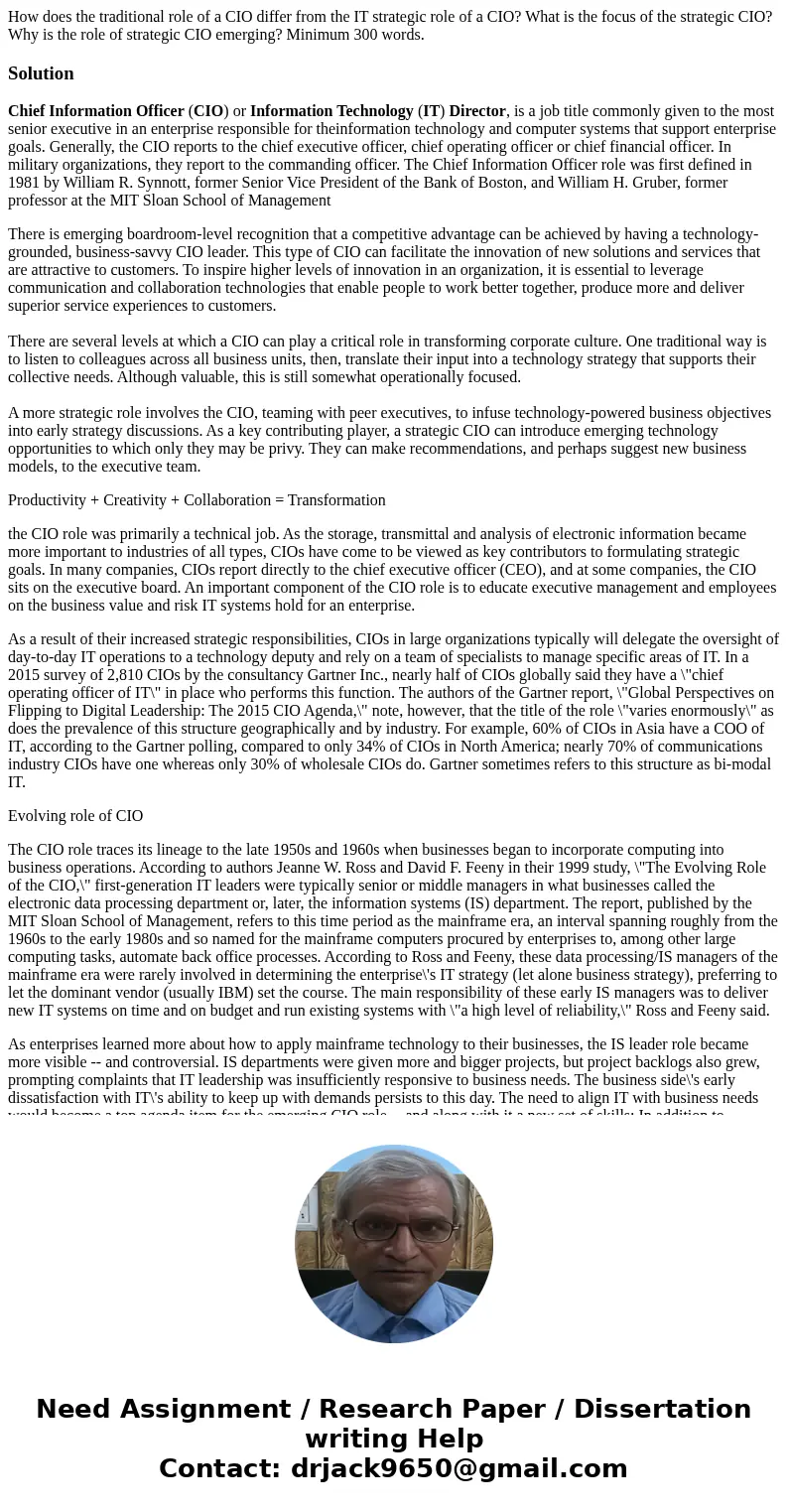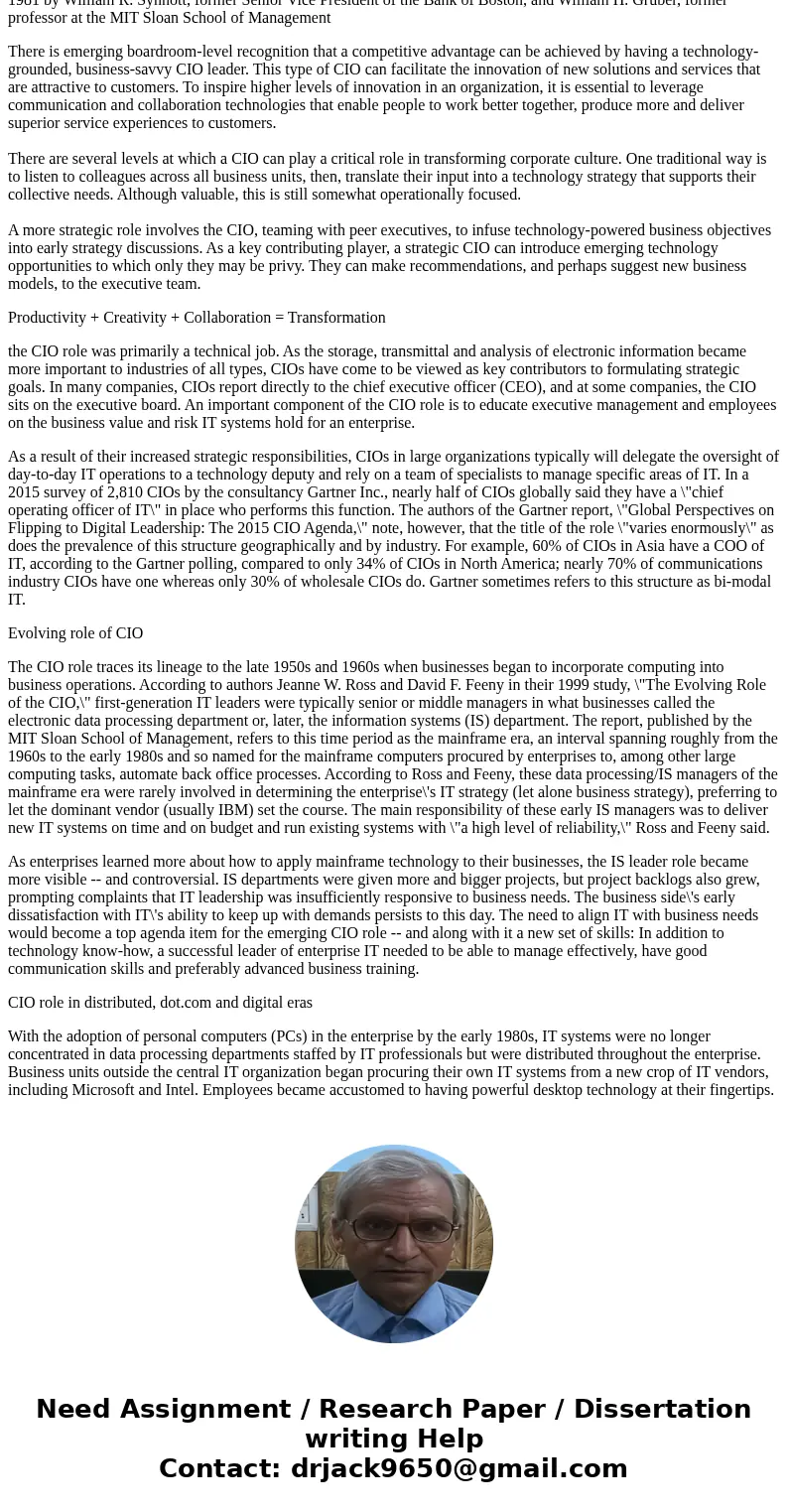How does the traditional role of a CIO differ from the IT st
How does the traditional role of a CIO differ from the IT strategic role of a CIO? What is the focus of the strategic CIO? Why is the role of strategic CIO emerging? Minimum 300 words.
Solution
Chief Information Officer (CIO) or Information Technology (IT) Director, is a job title commonly given to the most senior executive in an enterprise responsible for theinformation technology and computer systems that support enterprise goals. Generally, the CIO reports to the chief executive officer, chief operating officer or chief financial officer. In military organizations, they report to the commanding officer. The Chief Information Officer role was first defined in 1981 by William R. Synnott, former Senior Vice President of the Bank of Boston, and William H. Gruber, former professor at the MIT Sloan School of Management
There is emerging boardroom-level recognition that a competitive advantage can be achieved by having a technology-grounded, business-savvy CIO leader. This type of CIO can facilitate the innovation of new solutions and services that are attractive to customers. To inspire higher levels of innovation in an organization, it is essential to leverage communication and collaboration technologies that enable people to work better together, produce more and deliver superior service experiences to customers.
There are several levels at which a CIO can play a critical role in transforming corporate culture. One traditional way is to listen to colleagues across all business units, then, translate their input into a technology strategy that supports their collective needs. Although valuable, this is still somewhat operationally focused.
A more strategic role involves the CIO, teaming with peer executives, to infuse technology-powered business objectives into early strategy discussions. As a key contributing player, a strategic CIO can introduce emerging technology opportunities to which only they may be privy. They can make recommendations, and perhaps suggest new business models, to the executive team.
Productivity + Creativity + Collaboration = Transformation
the CIO role was primarily a technical job. As the storage, transmittal and analysis of electronic information became more important to industries of all types, CIOs have come to be viewed as key contributors to formulating strategic goals. In many companies, CIOs report directly to the chief executive officer (CEO), and at some companies, the CIO sits on the executive board. An important component of the CIO role is to educate executive management and employees on the business value and risk IT systems hold for an enterprise.
As a result of their increased strategic responsibilities, CIOs in large organizations typically will delegate the oversight of day-to-day IT operations to a technology deputy and rely on a team of specialists to manage specific areas of IT. In a 2015 survey of 2,810 CIOs by the consultancy Gartner Inc., nearly half of CIOs globally said they have a \"chief operating officer of IT\" in place who performs this function. The authors of the Gartner report, \"Global Perspectives on Flipping to Digital Leadership: The 2015 CIO Agenda,\" note, however, that the title of the role \"varies enormously\" as does the prevalence of this structure geographically and by industry. For example, 60% of CIOs in Asia have a COO of IT, according to the Gartner polling, compared to only 34% of CIOs in North America; nearly 70% of communications industry CIOs have one whereas only 30% of wholesale CIOs do. Gartner sometimes refers to this structure as bi-modal IT.
Evolving role of CIO
The CIO role traces its lineage to the late 1950s and 1960s when businesses began to incorporate computing into business operations. According to authors Jeanne W. Ross and David F. Feeny in their 1999 study, \"The Evolving Role of the CIO,\" first-generation IT leaders were typically senior or middle managers in what businesses called the electronic data processing department or, later, the information systems (IS) department. The report, published by the MIT Sloan School of Management, refers to this time period as the mainframe era, an interval spanning roughly from the 1960s to the early 1980s and so named for the mainframe computers procured by enterprises to, among other large computing tasks, automate back office processes. According to Ross and Feeny, these data processing/IS managers of the mainframe era were rarely involved in determining the enterprise\'s IT strategy (let alone business strategy), preferring to let the dominant vendor (usually IBM) set the course. The main responsibility of these early IS managers was to deliver new IT systems on time and on budget and run existing systems with \"a high level of reliability,\" Ross and Feeny said.
As enterprises learned more about how to apply mainframe technology to their businesses, the IS leader role became more visible -- and controversial. IS departments were given more and bigger projects, but project backlogs also grew, prompting complaints that IT leadership was insufficiently responsive to business needs. The business side\'s early dissatisfaction with IT\'s ability to keep up with demands persists to this day. The need to align IT with business needs would become a top agenda item for the emerging CIO role -- and along with it a new set of skills: In addition to technology know-how, a successful leader of enterprise IT needed to be able to manage effectively, have good communication skills and preferably advanced business training.
CIO role in distributed, dot.com and digital eras
With the adoption of personal computers (PCs) in the enterprise by the early 1980s, IT systems were no longer concentrated in data processing departments staffed by IT professionals but were distributed throughout the enterprise. Business units outside the central IT organization began procuring their own IT systems from a new crop of IT vendors, including Microsoft and Intel. Employees became accustomed to having powerful desktop technology at their fingertips.


 Homework Sourse
Homework Sourse